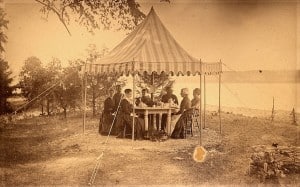Fossenvue
(From November 1998 Historical Society Newsletter)
It began on a summer day in July 1875 when a group of friends gathered at Lochland and decided to embark upon a camping adventure. The seven, including Ruth Lesley VerPlanck, Emily Dilworth Snyder, James Fowler, Anne Fitzhugh Miller, and Elizabeth Smith Miller, gathered provisions together and set off down Seneca Lake.
The site they chose that first summer was Fausett’s Point, one mile north of North Hector on the eastern shore of Seneca Lake. Its cold and never-failing spring and the shelter of its majestic trees had been used by many for picnics, making the party familiar with the ground. The site had been named for Captain George Fausett who had settled in the area after the Sullivan Campaign.
The set-up of the camp the first summer was recorded by Fawcett, a photographer from Watkins Glen who arrived at the site with cameras, tripods, and wet plates. Subsequent seasons at the camp were also recorded, though the photographer in later years is not identified. The camp name, Fossenvue, is a rearrangement of the words, “Seven of Us” which were how many landed at Fausett’s Point that first summer. Elizabeth Smith Miller is credited with winning the contest to coin a word for the camp, winning a cooking apron. Visits to the camp continued and it is noted that the property was rented from George Pedmore by Misses R.I VerPlanck and Anne Fitzhugh Miller. Several camp buildings were erected during the first five years, including a 30 x 15 central building, three tents, and two bathhouses.
On the occasion of the twenty-fifth anniversary of the camp, Embers from Fossenvue Backlogs, 1875-1900, was published. The book describes the history of the camp, documents the progress of buildings on the site, and included photographs of the camp and its residents over the years. In addition, it includes published articles about the site, including a Geneva newspaper account and one from the Woman’s Journal in 1901.
The published volume about the camp is filled with poetry, much of which related to life at the camp and observations of nature that were observed in the area. Photographs and drawings help to document the first twenty-five years on the Pont. The excerpts included in this volume are apparently gathered from logs that were kept each summer at the camp and while they reveal much about the intellectual activities at the camp, they do not tell of the day-to-day activities that occurred there.
Recently, an original Fossenvue log was loaned to the Historical Society from a private collection and the examination of this volume tells much about what occurred on a daily basis at the Point. Dated for the 1908 season, the leather volume begins with a discussion of the journey to Fossenvue from Lochland on July 30 and continues with daily entries until the camp was closed on October 6th. It appears that only Anne Fitzhugh Miller was among the campers setting out for Fossenvue that July day who was part of the original seven that had arrived there 33 years earlier.
Daily accounts begin with the weather and highlights activities that take place in the camp. The journal documents visitors to the camp throughout the season and includes signatures from each in the midst of the daily entries. No one person seems to have been responsible for recording activities at the camp, with a variety of handwriting appearing throughout the summer. The journal records swimming, the first game of volleyball played at the camp, activities for children visitors such as poetry contests, bonfires, and nature hikes. The written entries are highlighted with drawings, poems, quotations, and photographs. In addition, newspaper clippings document items mentioned in the journal or persons that visited the camp. For example, one visitor to the camp, Elizabeth Ellsworth Cook, writes about her journey to the site in a story she entitles “The Rough Way.” A newspaper clipping in the book reveals that Miss Cook is a graduate of Cornell and has just been given a position at a Wall Street firm as a bond expert. Another set of newspaper clippings detail the September opening of William Smith College, mentioned in a journal entry, and a letter from Milton Turk, dean of the college, is pasted in the book expressing regret to Anne was unable to attend the opening ceremonies. The volume also mentions outside interests of the Millers, including the arrival of a member of the Political Equality Club with the groups’ yearly scrapbook for the campers to help finish. (Many of the scrapbooks kept by the Club are now in the collection of the Library of Congress).
The exact year that the camp was closed permanently is not known. Elizabeth Smith Miller died in 1911 and her daughter Anne the following year. It is assumed that with their deaths, the camp ceased to convene.
Additional Information About Fossenvue



This is very interesting. Is there someone who does a presentation about this? I am looking for a speaker for a program in May 23.
I don’t know of anyone currently doing a program on Fossenvue. Kari Lusk did a one for us back in 2004 when she worked for the Finger Lakes National Forest Service in Hector. I don’t think she is there any more. Rosemary Plakas also did a program on the Miller scrapbooks for us in 2009. She was curator at the Library of Congress then, but has since retired. You could try reaching out to Professor Chris Woodworth at Hobart and William Smith Colleges. She has done theatrical projects related to Elizabeth Smith Miller and suffrage. Good luck.